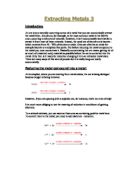Reduction using a more reactive metal
Titanium is formed by reducing titanium (IV) chloride with a more reactive metal such as sodium or magnesium.
The more reactive metal sodium releases electrons simply as it forms its ions:
These electrons are used to lessen the titanium (IV) chloride:
The negative aspect of this is expenditure. You have first to extort (or to purchase) the sodium or magnesium. The more reactive the metal is the further intricate and pricey the extraction becomes. That means that you have to use an extremely expensive reducing agent to extract the titanium. This method would be a long-term way but effective on gold and iron.
Electrolysis:
This is a widespread extraction procedure for the more reactive metals - for example, aluminum, gold and lead and not to mention the metals above them in the reactivity series. You may also come across it in other cases such as an individual manner of extracting copper and in the refinement of copper. Throughout electrolysis, electrons are being added straightforwardly to the metal ions at the cathode (the negative electrode). The disadvantage (predominantly in the aluminum case) is the price of the electricity. A benefit is that it can produce very pure metals. This procedure would be really efficient in terms of extracting aluminum and gold but not iron due to the ore properties.
Conversion of the aluminum oxide into aluminum by electrolysis
The aluminum oxide is electrolyzed in solution in molten cryolite, Na3AlF6. Cryolite is another kind of aluminum ore (bauxite), but is rare and costly, and most is now manufactured chemically.
The electrolysis cell
The diagram shows a very simplified version of an electrolysis cell.
Although the carbon lining of the cell is labeled as the cathode, the effectual cathode is chiefly the molten aluminum that forms on the base of the cell. Molten aluminum is siphoned out of the cell from time to time, and fresh aluminum oxide supplemented at the peak. The cell operates at a low voltage of about 5 - 6 volts, however at vast currents of 100,000 amps or more. The heating outcome of these large currents maintains the cell at a temperature of about 1000°C.
The electrode reactions
These are very complex - in fact one foundation that has been looked at says that they aren't fully understood. For chemistry purposes at this level, they are always simplified. This is the simplification:
Aluminum is released at the cathode. Aluminum ions are reduced by gaining 3 electrons.
Oxygen is produced initially at the anode.
However, at the temperature of the cell, the carbon anodes blaze in this oxygen to provide carbon dioxide and carbon monoxide. Persistent replacement of the anodes is a foremost expense.
The Redox and Displacement Reactions:
Redox (short for reduction-oxidation) reactions describe all chemical reactions in which atoms have their oxidation number (oxidation state) changed. This can be either a simple redox process, such as the oxidation of carbon to yield carbon dioxide or the reduction of carbon by hydrogen to yield methane, or a complex process such as the oxidation of sugar in the human body through a series of complex electron transfer processes.
The term comes from the two concepts of reduction and oxidation. It can be explained in simple terms:
- Oxidation is the loss of electrons or an increase in oxidation state by a molecule, atom, or ion.
-
Reduction is the gain of electrons or a decrease in oxidation state by a molecule, atom, or ion.
A displacement reaction, also called single-replacement reaction, is a type of oxidation-reduction chemical reaction when an element or ion moves out of one compound and into another. (One element is replaced by another in a compound.) This is usually written as
A + BX → AX + B
This will occur if A is more reactive than B. You can refer to the reactivity series to be sure of this.
A & B must be either:
- different metals (hydrogen's behavior as a caution renders it as a metal here), in which case X represents an anion; or
- Halogens, in which case X represents a caution.
In either case, when AX and BX is aqueous compounds (which is usually the case), X is a spectator ion.
In conclusion redox and displacement reactions could be severe and dangerous. In some cases they aren’t efficient and reliable. They waste resources and it is a lengthy process. The process might not be recommended in terms of extracting iron, aluminum or gold.
Conclusion:
Summing up all the ways and methods you could extract aluminum, gold and iron; electrolysis would be the best and most efficiently reliable method which does not waste resources, fuel or much money. It may be costly in some situations and in some terms but it is worth the payment. Out of all the methods listed above electrolysis would be the most quickest and fast paced way of extracting these metals. Basically it is the most dominant procedure compared to the rest and only has one disadvantage which would be the electrical price. Electrolysis is the separating of a compound into its constituent elements by passing an electrical current through it when in a molten or aqueous state. The word electrolysis means the process of breaking molecules to smaller parts by using an electric current. Positive and negative poles of an electric source, such as a battery, can absorb opposite ions of an electrolyte, causing separation of ions and creation of a new substance. Electrolysis is a chemical change. Ergo it is in overall the superlative technique.







